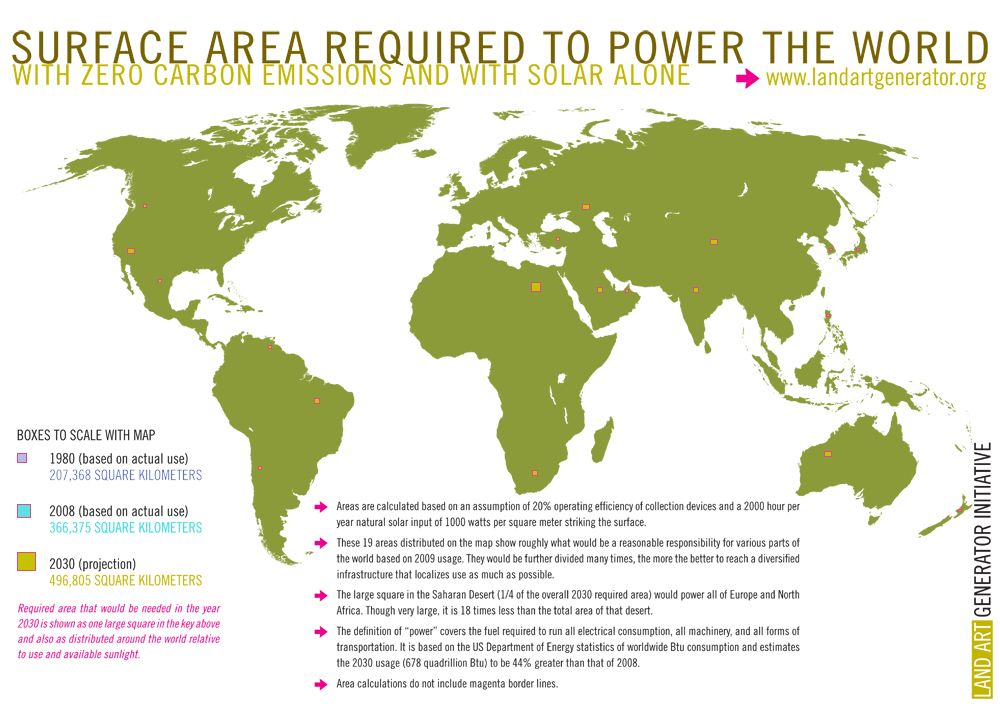
Larger image (1 MB): http://landartgenerator.org/pdf/PosterSolar.pdf
Credit: Land Art Generator Initiative
Solar panels convert light from the Sun into electricity. It’s likely there are a number of them on your roof or a roof near you. Are there enough roofs or other unused surface area to power your city? Your state? Country? World? Or would land area have to diverted from other purposes?
The US Department of Energy calculated, in 2009, that by 2030, world energy consumption in all forms would be 678 quadrillion BTU1 (715 exaJoules2,3).
So, what area of solar panels is required to produce that amount of energy from sunlight?
http://landartgenerator.org/blagi/archives/127
__________
1 “British thermal unit”, https://en.wikipedia.org/wiki/British_thermal_unit
2 “Joule”, https://en.wikipedia.org/wiki/Joule
3 “exaJoule”, https://en.wikipedia.org/wiki/Joule#Exajoule / 2009 International Energy Agency IEA updated estimates implementation of demand-side efficiency measures worldwide long-range estimates overestimated US Department of Energy Energy Information Administration world consumption of energy all formsbarrels of petroleum cubic meters natural gas watts of hydro power projected 678 quadrillion BTU 715 exajoules 2030 44% increase over 2008 levels 1980 were 283 quadrillion BTU 500 quadrillion BTU 2009 surface area infrastructural investment amount of power using only solar panels create fuel vehicles equipment electricity generated create hydrogen big number 678,000,000,000,000,000 BTU kWh Btu kWh kiloWatt hours 198,721,800,000,000 kWh 199,721 tWh average household uses approximately 18,000 kWh per year 1/11 billion of the total world usage capacity .2 kW per SM square metre meter of land efficiency of 20% 1000 watts 1 kW 1 kiloWatt capacity square meter capacity kW multiply number of hours square meters photovoltaic panel outputting 0.2kW capacity kilowatts x hours kWh 70% average sunshine days per year world Africa Arabian peninsula 250 sun days per year 8 hours of daylight average 2,000 hours per year direct sunlight multiply each square meter by 2,000 yearly kWh capacity per square meter of 400 kWh global yearly demand kWh per square meter 198,721,800,000,000 / 400 496,804,500,000 square meters 496,805 square kilometers 191,817 square miles area required to power the world with solar panels roughly equal to the area of Spain 5,000 super-site installations around the world average 25 per country measure less than 10km a side UAE United Arab Emirates plans construct 1,500MW capacity 2020 area 3 km per side power itself as a nation completely solar energy USA United Nations 170,000 square kilometers of forest destroyed each year constructed solar farms 1.2 million square kilometers farmland in China area of solar farm required power world in 2030 compare to Saharan Desert Saharan Desert 9,064,958 square kilometers 18 times the total required area to fuel the world another measure unpopulated area of the Sahara desert over 9 million km² square kilometres covered with solar panels provide 630 terawatts total power Earth’s current energy consumption rate 13.5 TW at any given moment including oil gas coal nuclear hydroelectric measure multiplier area needed very conservative compare highways area of US interstate highway system constructed 35 years 94,000 square kilometers US consumes 20% of the world’s energy area of USA highway run the world nation required infrastructure golf courses typical golf course covers square kilometer worst case scenario projections 2030 growth BTU load sources of clean energy wave energy
world wave energy potential 2,100,000,000,000 kWh 2,100 tWh required load wind 5 MW turbine 17 gWh per year turbines manufacturing machine installation turbine existing hydroelectric environment construct dams rivers design new large-scale hydro effect ecosystems watersheds existing river well-planned run-of-the-river projects hydroelectric power accounted for 6% of the energy production in the world technologies improving efficiencies technology will continue to get better and better /